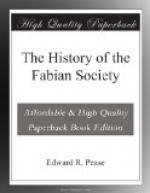Rule, and as Labour support was essential to the continuance
of the Liberals in power, they were debarred from pushing
their own proposals regardless of consequences.
Although therefore the party was pledged to the demand
for Women’s Franchise, they refused to wreck
the Government on its behalf. Hence impatient
Socialists and extreme Suffragists united in proclaiming
that the Labour Party was no longer of any use, and
that “direct action” by Suffragettes and
Trade Unionists was the only method of progress.
The “Daily Herald,” a newspaper started
by a group of compositors in London, was acquired by
partisans of this policy, and as long as it lived incessantly
derided the Labour Party and advocated Women’s
Franchise and some sort of Syndicalism as the social
panacea. Moreover a variant on Syndicalism, of
a more reasoned and less revolutionary character, called
“Guild Socialism,” was proposed by Mr.
A.R. Orage in the pages of his weekly, “The
New Age,” and gained a following especially in
Oxford, where Mr. G.D.H. Cole was leader of the
University Fabian Society. His book on Trade
Unionism, entitled “The World of Labour,”
published at the end of 1913, attracted much attention,
and he threw himself with great energy into the Trade
Union enquiry of the Research Department, of which
his friend and ally, Mr. W. Mellor, was the Secretary.
Mr. Cole was elected to the Executive Committee in
April, 1914, and soon afterwards began a new “Reform”
movement. He had become a prophet of the “Guild
Socialism” school, and was at that time extremely
hostile to the Labour Party. Indeed a year before,
when dissatisfaction with the party was prevalent,
he had proposed at a business meeting that the Fabian
Society should disaffiliate, but he had failed to
carry his resolution by 92 votes against 48.
In the summer of 1914 however he arrived at an understanding
with Mr. Clifford Allen, also a member of the Executive,
and with other out and out supporters of the Labour
Party, by which they agreed to combine their altogether
inconsistent policies into a single new program for
the Fabian Society. The program of the “several
schools of thought,” published in “Fabian
News” for April, 1915, laid down that the object
of the Society should be to carry out research, that
the Basis should be replaced merely by the phrase,
“The Fabian Society consists of Socialists and
forms part of the national and international movement
for the emancipation of the community from the capitalist
system”; and that a new rule should be adopted
forbidding members to belong to, or publicly to associate
with, any organisation opposed to that movement of
which this Society had declared itself a part.
The Executive Committee published a lengthy rejoinder,
and at the election of the Executive Committee a few
weeks later the members by their votes clearly indicated
their disapproval of the new scheme. At the Annual
Meeting in May, 1915, only small minorities supported
the plan of reconstruction, and Mr. Cole then and
there resigned his membership of the Society, and was
subsequently followed by a few other members.
A little while later the Oxford University Fabian
Society severed its connection with the parent Society,
and Mr. Cole adopted the wise course of founding a
society of his own for the advocacy of Guild Socialism.




